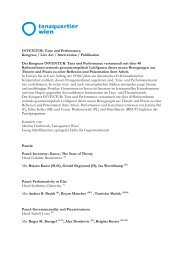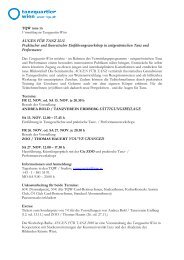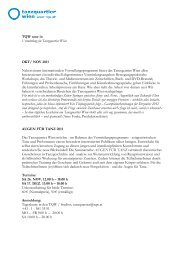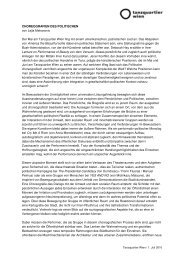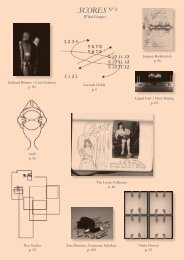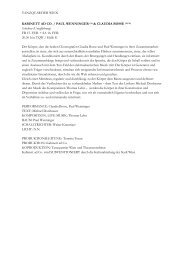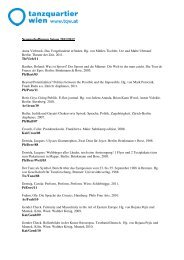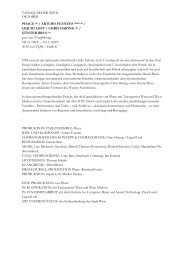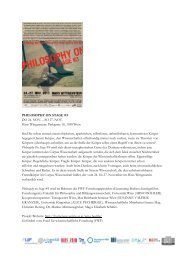SCORES NO 0 - Tanzquartier Wien
SCORES NO 0 - Tanzquartier Wien
SCORES NO 0 - Tanzquartier Wien
You also want an ePaper? Increase the reach of your titles
YUMPU automatically turns print PDFs into web optimized ePapers that Google loves.
Gerald Siegmund / Boris Charmatz / Janez Janša /<br />
What if we made it all up?<br />
Gerald Siegmund Boris, in the piece 50 years of dance you worked with<br />
all the images in David Vaughan’s book Merce Cunningham, Fifty Years. you<br />
used the photographs as a choreographic structure to organise the piece. The<br />
images contain a certain kind of information, but leave out others. how did you<br />
confront yourself with those images in the process of creating the piece?<br />
Boris Charmatz In my work up until now I always thought that we should<br />
fight images. As dancers we always used to work in front of mirrors and now... we<br />
always work in front of cameras! Everybody is always confronted with advertisement<br />
and pictures of the body. Therefore one could be mislead to think that the dancer is<br />
organizing movement only because he or she shapes his own body to produce an ideal<br />
image. I, on the other hand, always thought we should go back to action, back to doing<br />
things and push the pictures aside. As dancers we should resist the picture-effect.<br />
But one day I remember I was with Laurence Louppe, one of the most important<br />
French critics and dance scholars. She was looking at pictures from the sixties and<br />
said: » Oh there is so much in them «. Up until then I had thought they are only traces,<br />
they are not the real thing – the movement, the performance. But she insisted that I<br />
take a closer look. Of course first you may think they only capture one second. you<br />
see a jump, so it ’s a jump. But in fact there is so much more to be seen: the costumes<br />
and the light used, the atmosphere, the hair cut. Even if it is only a jump, you can<br />
predict how they came to this jump. From that one exercise or one shape of the arm<br />
you could already reconstruct a whole philosophy, even metaphysics of the body.<br />
I received David Vaughan’s book as a Christmas present from my father. That ’s how it<br />
all started. There is of course a close relationship between Modern Dance and development<br />
of film and photography which is really part of our history as dancers. Modern Dance<br />
was accompanied with a lot of pictures. Merce Cunningham’s work is always related to<br />
video and media. So I was looking at this book and, in a way, I was not too happy to<br />
have it. But after a while I thought, that in a strange way the book reconstructs a process<br />
that is not so far from Merce Cunningham’s process of developing a piece. In fact, it ’s<br />
written on the back page of the English version: These pictures re-enact a dance full<br />
of energy, full of liveliness. That there was dance in it became really clear to me when I<br />
was flipping the pages. The connection between the first page and the second page was<br />
just as absurd as the choreographies of Merce himself!!! So I thought we could work<br />
with the book by considering the pictures already as a dance. This is how it started.<br />
First I started to work with people who didn ’t know anything about Merce<br />
Cunningham, or John Cage, or American Dance. The main thing was to work in the absence<br />
of a choreographer. Maybe that ’s what choreography is: when abstract things are inscribed in<br />
the body. Of course it ’s very useful when the choreographer is present to show you, to touch<br />
and to take care that you do the right movement. A lot of teaching and learning choreography<br />
is done by oral transmission. The first pleasure with 50 Years of Dance was » He is not here,<br />
he will not tell us how to do it «. So we just started to reincorporate the pictures, trying to<br />
be ourselves in the picture which, unfortunately, is a thing that never works. you are never<br />
a picture and you are never fully doing what you like, because you are facing a monster.<br />
18<br />
<strong>SCORES</strong> <strong>NO</strong> 0 — Autumn 2010<br />
Gerald Siegmund The information in the pictures you were trying to retranslate<br />
into a sequence of movement, however, is not always that clear. If the image<br />
depicts some kind of posture or figure, there is still no way you can tell how the<br />
dancers in the picture came to do this precisely, which amount of energy was used,<br />
which parts of the body were activated to produce this. So I assume you had to make<br />
choices and take decisions on how to produce the movement by reading pictures.<br />
Boris Charmatz In fact, when the dancers of the » fifty years of dance « look at<br />
the picture for some time, they know where the pose comes from. you may only see ONE<br />
picture, but for the dancers it ’s a 30 minute piece. If you consider any of the pictures in the<br />
book – regardless of what you know about Merce Cunningham – you could guess that he<br />
was educated in western societies or educated on the ground with crossed legs all the time.<br />
In fact there is much more to be read in a picture. There is always a lot of information to be<br />
gathered from your posture, from the way you hold yourself, you can guess how the other<br />
person will talk, you can guess what kind of voice he or she has. you could say it ’s only<br />
guessing. But even before you move there is already a lot of movement that is inscribed.<br />
Gerald Siegmund In your piece there are at least two different types of archives<br />
that you worked with. First, the pictures themselves function as an archive that also<br />
provide you with the choreographic structure of the piece because you followed their<br />
order chronologically. Second, in the version of the piece that you show here at the<br />
<strong>Tanzquartier</strong> in Vienna there is the physical archive of these seven wonderful dancers<br />
from Merce Cunningham’s Company that you worked with. Since they have been trained<br />
in Cunningham technique and have themselves danced in some of the pieces shown in<br />
the book they have an intimate physical knowledge of how to inscribe the information.<br />
Boris Charmatz We argued a lot, because all the dancers spent time with<br />
Merce Cunningham in different periods of his work. Since Cunningham was active in<br />
the 1950ies, 1960ies, 1970ies, 1980ies, 1990ies and the 2000s, they maybe weren ’t facing<br />
exactly the same person. I am actually convinced that even if you don ’t know anything<br />
about Merce Cunningham, you are able to grasp things from just looking at the pictures.<br />
I made this experience during a project with Le Quatuor Albrecht Knust where we<br />
worked on The afternoon of a faun. There is a poem of Mallarmé, the music of Debussy<br />
and the score and the dance of Vaslav Nijinsky. The four choreographers and scholars<br />
of le Quatuor asked all the dancers what they know about The afternoon of a faun. All the<br />
dancers involved in this project, fist of all myself, said: » I don ’t know anything about<br />
Nijinsky «. And after a while I really start whistling the music! It ’s the same with these<br />
pictures or with, say, an arabesque. Even if you don ’t know how to name an arabesque<br />
and you see it, it is still possible to reconstruct it. you can find in yourself a kind of<br />
archaeology of things you thought you would never know, but you actually do know.<br />
Gerald Siegmund Do you think this is because of the cultural<br />
context? It implies that just because you ’re born in a certain culture, you<br />
were exposed to certain pieces of art and certain traditions that even<br />
though you ’re not a dancer you would find the dancer in yourself?<br />
19<br />
Boris Charmatz / Janez Janša / Gerald Siegmund What if we made it all up?



